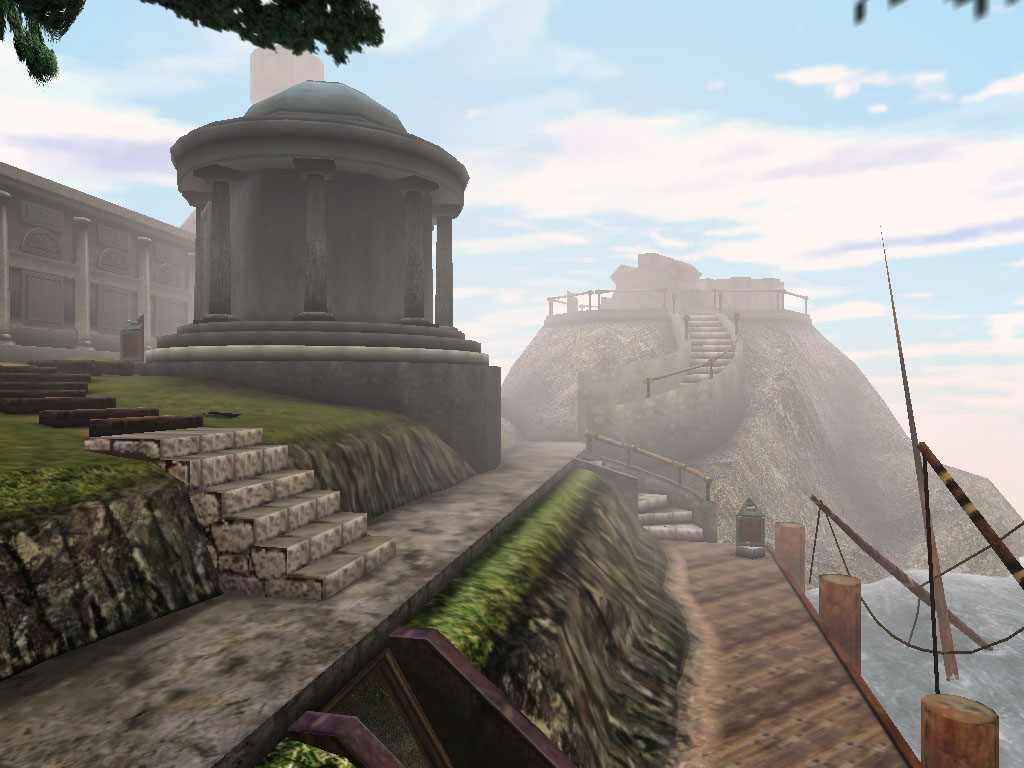Now let's split them up in a new way. There are games which are movie-like, and
games which are book-like.
Movie-like games are games that go for as much realism as
possible for graphics, physics, sound, and so on. They try to make you feel like you are truly
in another world, battling aliens or terrorists or whathaveyou. Movie-like games are more common today than
they ever have been, particularly in the hardcore market.
Book-like games are games that abstract out a lot and
require you to use your imagination.
They may have simple graphics and unrealistic mechanics. Book-like games are the way games began, and
they continue to be popular for both casual and hardcore gamers.
The line on the scale for differentiating the two is fuzzy
and is constantly moving. In general,
however, you can say that the clearer the image, the more movie-like it is.
Way back when, book-like games were all there were. Pong is book-like. You have to use your imagination (if you want
to) to pretend those lines are Ping Pong paddles and the little white square
pixel is a ball (this was before we had color... or circles). Text-based Adventures are book-like, of
course.
Super Mario Bros. is book-like. While the forms are there, and you don't have
to use much imagination to see what
you're supposed to see, that fire flower isn't all that flowery.
Indeed, consider the current picture of Mario, and compare
him to his first appearance as Jumpman in Donkey Kong. As Mario evolved, artists used their
imaginations and skills to give Mario more detail. His basic form is there, but heck, you might
not even consider that he's wearing overalls.
Who can really say? You must use
your imagination to fill in the details and decide what Mario looks like, until
we have better images of him.
 |
| I'm pretty sure that's ET, not a flower. |
Some games tried live action shots, particularly Adventure
Games like The 7th Guest; others only used live actors in cutscenes, like many
games on the Sega CD. Now these are
pretty much extinct, because graphics in games are becoming so good, CGI is
just as good.
That is, we think so, until the next round of impressive
graphics appears.
I used to think that MYST island was photorealistic. I believed I was walking around a real
island. But then graphics got better,
and even its sequel, Riven, completely destroyed the idea that MYST was ever
anything more than a detailed cartoon.
You can look back at MYST now and wonder what the big deal was.
So as games become more realistic, the like between what is
movie-like and what is book-like shifts.
What was once thought to be photorealistic is now most definitely
not. But that doesn't mean MYST takes
the same amount of imagination to understand as Donkey Kong.
 |
| And then they remade it to be even more realistic, and even the remake looks a bit meh. |
In fact, MYST takes hardly any imagination at all, in terms
of graphics. The bookshelf still
obviously looks like a bookshelf, the sailing ship looks like a sailing ship,
and no one in their right mind would question it.
Yet if you were unfamiliar with Donkey Kong, would you know
what everything is? Do you know what
everything is, even though you supposedly already know? Sure, you know about the barrels and hammer
and gorilla and ladders, but what are the platforms you are walking on? Those are more than just platforms. Those are supposed to be steel girders and
catwalks. You're not climbing an
abstract series of platforms; you're climbing a building under
construction. And that takes a ton of imagination.
Yet many modern games mix the two. Take any RPG, for example. The cutscenes are, of course,
movie-like. Depending on just how good
the graphics are, the exploration might be movie-like as well. But if the battle system is turn-based,
menu-based, or in any other way not strictly action-oriented, then it's being
abstracted out, and is book-like. Even
in the world of that RPG, battles aren't really turn-based, because sometimes
impressive action sequences occur in the cutscenes. So the game offers a place for your
imagination to take over.
That is not to say that either type of game is bad; my
favorite games cover every piece of the spectrum. God of War is a 99 on a 100 point movie-like
scale, and Dwarf Fortress is a 99 on the book-like scale. Both games are awesome.
I do wonder, however, about how smooth the transitions are
in games that are somewhere in the middle.
For some, it's no problem at all.
RPG players bounce back and forth every couple of minutes.
But I wonder if bouncing takes getting used to or if we can
easily do it without experience. I grew
up playing book-likes, movie-likes, and mixes, so I never considered the
difference.
But suppose someone who has never played a videogame before
is being introduced to one. Do you give
them one extreme, the other, or something in the middle? Perhaps what matters is how much the inductee
likes to use his imagination. Perhaps an
avid book reader would like a book-like game, while an avid movie watcher wants
a movie-like game. To give them the
opposite might turn them off from games.
Think about someone you know who doesn't play games. Think about their personality and interests,
and consider which kind of game they are more likely to take a liking to. Introduce them to a game you think they might
like based on this dynamic, and post the results in the comments.
 |
| "Who keeps throwing these bricks down this well? That's what I want to know." |
No comments:
Post a Comment